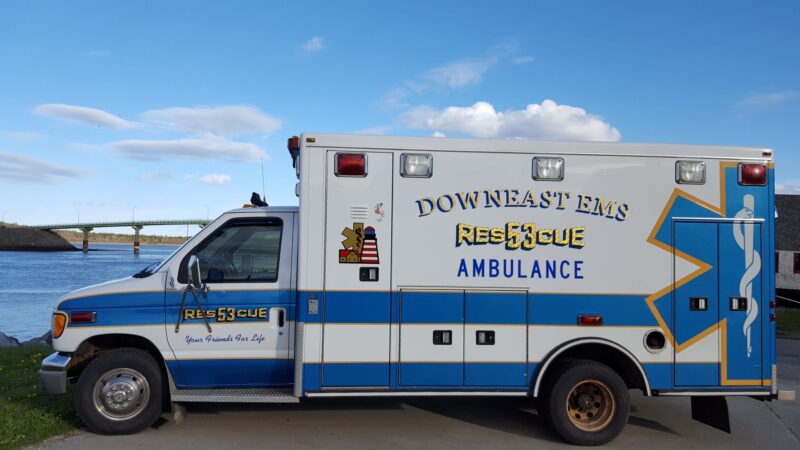Representatives of Washington County ambulance companies, area hospitals, emergency dispatch operations, and state and town officials gathered Thursday in Columbia Falls to triage the financially troubled county emergency response system.
Proposed solutions ranged from increasing the amount that towns pay for the ambulance services to urging the legislature to pass a spending bill that would shore up emergency services across the state.
“I’ve had to tell screaming people that are watching people dying in front of them, ‘I’m trying to find an ambulance to send you right now,’ ” said Dennis Perry, the operational supervisor for the Washington County 9-1-1 Regional Communications Center. “I’ve instructed more people over the phone on CPR more times than I care to — and sometimes we’re doing it for a hell of a long time.”
Dispatchers and all 10 of the county’s understaffed and underfunded ambulance services have warned about the system with increasing urgency over the past few years. Last month the concern grew when the chief of Petit Manan Ambulance Corps announced it would shut down without an immediate infusion of additional funds. Other companies say they too are barely surviving.
RELATED: Washington County emergency medical system approaches a crisis
The meeting was convened by Rick Petrie, the special projects advisor for Atlantic Partners EMS, a nonprofit statewide EMS agency that provides support and lobbies on behalf of EMS professionals. Speaking to the group at the Wreaths Across America gym in Columbia Falls, Petrie said every rural ambulance company is guaranteed to lose money because of what he called a flawed reimbursement system.
Petrie said the problem can no longer be ignored.
“We need to make the phone calls. We need to tell people both in the state and in Washington just how bad this is,” said Petrie. “And we desperately need your help because we have ambulance services that are closing their doors.”
Data shows that most ambulance calls are for patients who receive Medicare or Medicaid (MaineCare), with those insurers covering only about 80 percent of the costs. Petrie explained that rural ambulance services are most at risk because they do a much smaller volume of calls than places such as Portland, so they have little ability to make up the shortfall. That means the losses — about $2,000 on every call — have to come from somewhere else.
Washington County municipalities do little to staunch the bleeding.
At the higher end, Lubec pays Downeast EMS about $90,000 per year. At the lower end, Steuben gives Petit Manan $5,500 for covering its approximately 1,126 residents. Milbridge, the other town served by Petit Manan, kicks in $2,500 for its 1,265 residents.
Nancy Parritt, the chief for the Petit Manan Ambulance Corps, wants both towns’ select boards to pay more, asking for $25 per capita. The answer was a resounding no.
Neighboring Pleasant River Ambulance Service charges each of the four towns it serves $81 per capita and, as a result, is more stable.
“Every (resident) that I have talked to in Milbridge and Steuben was very upset because they said they would pay $25 per person a year. They would do it to keep our ambulance,” said Parritt at Thursday’s meeting.
The pay scale for EMTs varies according to each town, with most only paying EMTs and paramedics for the time spent treating and transferring patients, despite often being on call for back-to-back eight-hour shifts due to severe staffing shortages. Although county EMTs can earn about $16 an hour and paramedics a little over $20,000 annually, many do not.
“We know that EMTs are volunteering their time or they’re making $3.25 an hour,” said Melissa Adams with Maine EMS, a bureau within Maine’s Department of Public Safety. “But our elected officials think that that’s OK … because that’s the way we’ve always done it.”
One Steuben resident at the meeting said she was shocked to learn how poorly many EMTs are paid. “That’s horrible. I’m ashamed. We need to keep them.”
Responding to the criticism, Milbridge town manager and police chief Lewis Pinkham said EMS is not their only concern. “Law enforcement is on the other end of the problem as well,” said Pinkham. “You’ve got towns offering $30,000 bonuses and still can’t find anyone.”
Dr. David Saquet, an emergency physician with Northern Light and the Northeastern Regional medical director for AP EMS, said they also struggle with staffing. “We can’t find people to come work for us,” said Saquet. “We have to take people to the airport, put them on a plane and we fly them two states over because we don’t have any beds statewide because of the same problems you guys are having.”
Petrie starkly reminded the group that the focus of the meeting was to find solutions.
“The only way we move forward, the only way we survive, is together. That’s it,” said Petrie. “There is no other way around it unless each of you want to pay $784,000 a year just to staff your ambulance and I don’t think we want to get to that.”
The good news, according to Petrie, is that bills have been presented in the state legislature taking up the recommendations of a blue-ribbon commission that called for $70 million of funding a year over five years to shore up EMS services statewide.
The commission report, released on Thursday, said that the state’s EMS systems are “in crisis.”
“EMS services in Maine are at the edge of a cliff, or over it, and changes must occur to ensure that when someone calls with a medical emergency, EMS services are able and ready to assist,” the report said.
If extra funding called for in the report is approved, Petrie said funding allocations need to favor rural EMS since they are the most endangered. But he and Adams said the infusion of money alone will not solve the problem.
“If we get any of that, it’s not long term. It’s not meant to sustain systems that aren’t working,” said Adams. “So there’s still work to be done locally, to make sure that we have a sustainable system.”
She and Petrie said a comprehensive, if not regional, “homegrown” approach is needed. Others agreed, chiming in with suggestions that included everything from better benefits and paid time off to prevent burnout; to recruiting at high schools and having the state pay for training.
“If the state is going to set protocols and standards, I would like to see the state be responsible for taking care of the training across the state for those standards that might relieve some of the financial burden,” said Charlene Hammond, chief for the Pleasant River Ambulance Service.
EMS and town officials said the hospitals also need to do their part to help pay for transports that often take ambulances out of service for an entire day, leaving their own communities vulnerable.
“Some days three of my four Western ambulances are down … I’m saying to one of them, ‘hey, Moosabec, can you turn and burn? I need you to be here,” said Perry. “At what point in the protocol do I ask (9-1-1 callers), do you have the ability to transport the person to the hospital yourself?”
Petrie urged those at the meeting to volunteer for the working group he is forming that he said should include representatives from the various stakeholders. Stressing the urgency, Petrie hopes to announce details and hold the first meeting shortly.
Sign up here to receive our free, periodic newsletter, Downeast Monitor, that focuses on Washington County news, a new offering at The Maine Monitor as part of our newsroom’s stepped-up efforts to cover Washington County. Know of a Washington County story we should look into? Send us an email: contact@themainemonitor.org or send the tip anonymously here.





